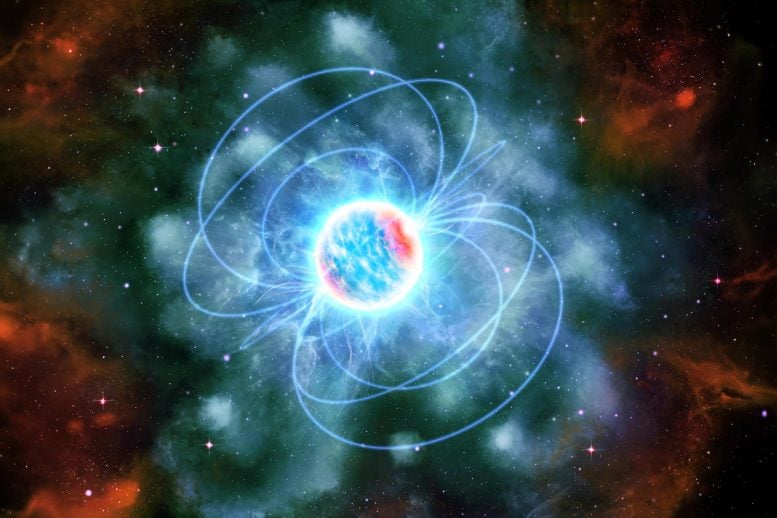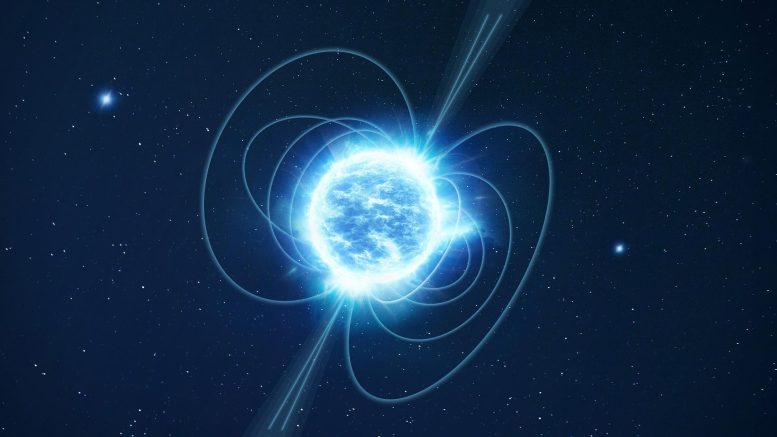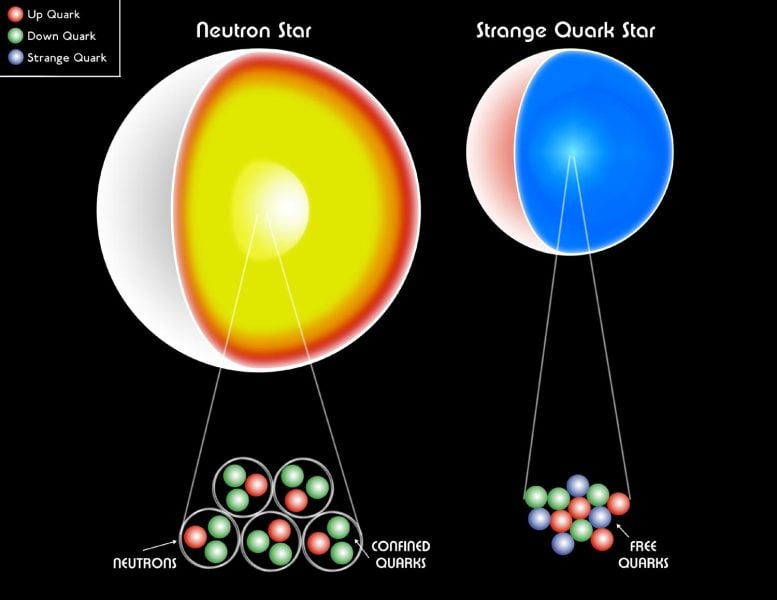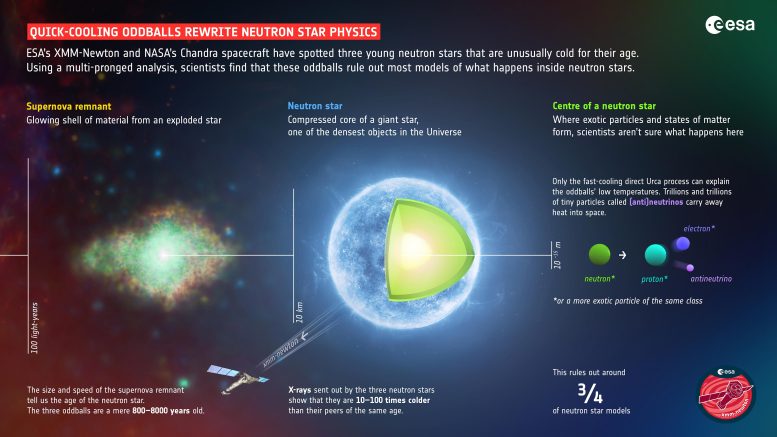
Neutron stars are some of the densest objects in the Universe. The material inside gets squeezed so hard that scientists don’t yet know what form it takes. The core of a neutron star might be made of a thick soup of quarks, or contain exotic particles that couldn’t survive anywhere else in the Universe. Credit: ICE-CSIC/D. Futselaar/Marino et al., edited
Recent observations by ESA’s XMM-Newton and NASA’s Chandra have revealed three unusually cold, young neutron stars, challenging current models by showing they cool much faster than expected.
This finding has significant implications, suggesting that only a few of the many proposed neutron star models are viable, and pointing to a potential breakthrough in linking the theories of general relativity and quantum mechanics through astrophysical observations.
Discovery of Unusually Cold Neutron Stars
ESA’s XMM-Newton and NASA’s Chandra spacecraft have detected three young neutron stars that are unusually cold for their age. By comparing their properties to different neutron star models, scientists conclude that the oddballs’ low temperatures disqualify around 75% of known models. This is a big step towards uncovering the one neutron star ‘equation of state’ that rules them all, with important implications for the fundamental laws of the Universe.

Besides black holes, neutron stars are among the most baffling objects in the Universe. A neutron star is formed in the last moments of the life of a very large star (with more than about eight times the mass as our Sun), when the nuclear fuel in its core eventually runs out. In a sudden and violent end, the outer layers of the star are ejected with monstrous energy in a supernova explosion, leaving behind spectacular clouds of interstellar material rich in dust and heavy metals. At the center of the cloud (nebula), the dense stellar core further contracts to form a neutron star. A black hole can also form when the remaining core’s mass is greater than about three solar masses. Credit: ESA
Extreme Density and Unknown States of Matter
After stellar mass black holes, neutron stars are the densest objects in the Universe. Each neutron star is the compressed core of a giant star, left behind after the star exploded in a supernova. After running out of fuel, the star’s core implodes under the force of gravity while its outer layers are blasted outward into space.
Matter in the center of a neutron star is squeezed so hard that scientists still don’t know what form it takes. Neutron stars get their name from the fact that under this immense pressure, even atoms collapse: electrons merge with atomic cores, turning protons into neutrons. But it might get even weirder, as the extreme heat and pressure may stabilize more exotic particles that don’t survive anywhere else, or possibly melt particles together into a swirling soup of their constituent quarks.

In a neutron star (left), the quarks that comprise the neutrons are confined inside the neutrons. In a quark star (right), the quarks are free, so they take up less space and the diameter of the star is smaller. Credit: NASA/CXC/M.Weiss
What happens inside a neutron star is described by the so-called ‘equation of state’, a theoretical model that describes what physical processes can occur inside a neutron star. The problem is, scientists don’t yet know which of the hundreds of possible equation of state models is correct. While the behavior of individual neutron stars may depend on properties like their mass or how fast they spin, all neutron stars must obey the same equation of state.
Implications of Neutron Star Cooling Observations
Digging into data from ESA’s XMM-Newton and NASA’s Chandra missions, scientists discovered three exceptionally young and cold neutron stars that are 10–100 times colder than their peers of the same age. By comparing their properties to the cooling rates predicted by different models, the researchers conclude that the existence of these three oddballs rules out most proposed equations of state.
“The young age and the cold surface temperature of these three neutron stars can only be explained by invoking a fast cooling mechanism. Since enhanced cooling can be activated only by certain equations of state, this allows us to exclude a significant portion of the possible models,” explains astrophysicist Nanda Rea, whose research group at the Institute of Space Sciences (ICE-CSIC) and Institute of Space Studies of Catalonia (IEEC) led the investigation.
Uniting Theories Through Neutron Star Study
Uncovering the true neutron star equation of state also has important implications for the fundamental laws of the Universe. Physicists famously don’t yet know how to stitch together the theory of general relativity (which describes the effects of gravity over large scales) with quantum mechanics (which describes what happens at the level of particles). Neutron stars are the best testing ground for this as they have densities and gravitation far beyond anything we can create on Earth.

Neutron stars are the compressed cores of giant stars, left behind after the star exploded in a supernova. They are so dense that a sugar cube’s amount of neutron star material would weigh as much as all the people on Earth! Credit: ESA
Joining Forces: Four Steps to Discovery
The three oddball neutron stars being so cold makes them too dim for most X-ray observatories to see. “The superb sensitivity of XMM-Newton and Chandra made it possible not only to detect these neutron stars, but to collect enough light to determine their temperatures and other properties,” says Camille Diez, ESA research fellow who works on XMM-Newton data.
However, the sensitive measurements were only the first step towards being able to draw conclusions about what these oddballs mean for the neutron star equation of state. To this end, Nanda’s research team at ICE-CSIC combined the complementary expertise of Alessio Marino, Clara Dehman, and Konstantinos Kovlakas.
Alessio led on determining the physical properties of the neutron stars. The team could deduce the temperatures of the neutron stars from the X-rays sent out from their surfaces, while the sizes and speeds of the surrounding supernova remnants gave an accurate indication of their ages.
Next, Clara took the lead on computing neutron star ‘cooling curves’ for equations of state that incorporate different cooling mechanisms. This entails plotting what each model predicts for how a neutron star’s luminosity – a characteristic directly related to its temperature – changes over time. The shape of these curves depends on several different properties of a neutron star, not all of which can be determined accurately from observations. For this reason, the team computed the cooling curves for a range of possible neutron star masses and magnetic field strengths.
Finally, a statistical analysis led by Konstantinos brought it all together. Using machine learning to determine how well the simulated cooling curves align with the oddballs’ properties showed that equations of state without a fast cooling mechanism have zero chance of matching the data.
“Neutron star research crosses many scientific disciplines, spanning from particle physics to gravitational waves. The success of this work demonstrates how fundamental teamwork is to advancing our understanding of the Universe,” concludes Nanda.
Reference: “Constraints on the dense matter equation of state from young and cold isolated neutron stars” by A. Marino, C. Dehman, K. Kovlakas, N. Rea, J. A. Pons and D. Viganò, 20 June 2024, Nature Astronomy.
DOI: 10.1038/s41550-024-02291-y










